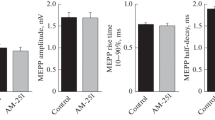Abstract
The possibility of postsynaptic potentiation (PSP) and desensitization developing due to nonquantal acetylcholine (ACh) secretion was investigated in mouse diaphragm with reference to time-amplitude relationships of miniature endplate currents (MEPC). The H effect (which characterizes nonquantal secretion (NS) of ACh) fell to zero over 3 h under the action of armine-induced inhibition of acetylcholinesterase (AChE) at a temperature of 20°C. A decline in the decay time constant (τ) of MEPC unaccompanied by observable alteration in MEPC amplitude occurred at the same time. This accelerated decay of MEPC was not observed in the absence of NS (the early stages of denervation). Start of NS did not show any effect on maximum retardation of MEPC decay due to AChE inhibition, indicating that no PSP sets in under the effects of non-quantal secretion. The effect of decline in τ accelerated with a rise in temperature; it could be reproduced with neostigmine replacing armine, while τ remained unchanged in the time spells investigated with AChE in its active state. Non-quantal ACh is not thought to produce substantial retardation of MEPC decay, although it does bring about desensitization, signs of which may be partially masked owing to concurrent onset of PSP.
Similar content being viewed by others
Literature cited
V. A. Voronin, "The part played by non-quantal release of acetylcholine in regulating membrane potential in muscle fiber," in: Physiology and Biochemistry of Transmitter Processes, Paper given at 4th National Conference, Moscow (1985).
R. A. Giniatullin, S. K. Bal'tser, E. E. Nikol'skii, and L. G. Magazanik, "Postsynaptic potentiation and desensitization induced in neuromuscular junctions by rhythmic stimulation of the motor nerve," Neirofiziologiya,18, No. 5, 645–654 (1986).
E. E. Nikol'skii and V. A. Voronin, "Temperature-related processes of spontaneous quantal and non-quantal transmitter release from the mouse motor nerve endings," Neirofiziologiya,18, No. 3, 361–367 (1986).
E. E. Nikol'skii, V. A. Voronin, and T. I. Oranskaya, "Dynamics of changes in spontaneous quantal and non-quantal acetylcholine secretion from the motor nerve endings after severing the nerve," Dokl. Akad. Nauk. SSSR,281, No. 3, 580–584 (1985).
N. N. Potap'eva and A. Snetkov, "Time course of effects of acetylcholinesterase inhibition at the neuromuscular junction," in: Mechanisms of Hormonal and Transmitter Action on Effector Cells (Paper given at National Conference, Suzdal' (1989).
A. Feltz and A. Trautmann, "Interaction between nerve-released acetylcholine and bath-applied agonist at the frog end-plate," J. Physiol.,299, 533–552 (1980).
R. A. Giniatullin, Kh. S. Khamitov, R. N. Khazipov, et al., "Development of desensitization during repetitive end-plate activity and single end-plate currents in frog muscle," J. Physiol.,412, 113–122 (1989).
M. I. Glavinovic, "Postsynaptic potentiation and desensitization in frog neuromuscular junction," Can. J. Physiol. Pharmacol.,66, No. 6, 624–629 (1988).
B. Katz and R. Miledi, "The binding of acetylcholine to receptor and its removal from the synaptic cleft," J. Physiol,231, No. 3, 549–574 (1973).
B. Katz and R. Miledi, "Transmitter leakage from motor nerve endings," Proc. R. Soc. Ser. B,196, No. 1, 59–72 (1977).
L. G. Magazanik and F. Vyskocil, "The effect of temperature on desensitization kinetics at the postsynaptic membrane of the frog muscle fibre," J. Physiol.,249, No. 1, 285–300 (1975).
K. L. Magleby and D. A. Terrar, "Factors affecting the time course of decay of end-plate currents: A possible cooperative action of acetylcholine on receptors at the frog neuromuscular junction," J. Physiol.,244, No. 2, 467–495 (1975).
J. F. Mitchel and A. Silver, "The spontaneous release of acetylcholine from the denervated hemidiaphragm of the rat," J. Physiol.,165, No. 1, 117–129 (1963).
E. F. Stanley and D. B. Drachman, "The effect of nerve section on the non-quantal release of ACh from motor nerve terminal," Brain Res.,365, No. 2, 289–292 (1986).
F. Vyskocil and P. Illesh, "Non-quantal release of transmitter at mouse neuromuscular junction and its dependence on the activity of Na-K-ATPase," Pflügers Arch.,370, No. 7, 295–297 (1977).
F. Vyskocil, E. E. Nikolsky, and C. Edwards, "An analysis of the mechanisms underlying the non-quantal release of acetylcholine at the mouse neuromuscular junction," Neuroscience,9, No. 2, 429–435 (1983).
H. Zemkova, F. Vyskocil, and C. Edwards, "A study on early postdenervated changes on non-quantal and quantal acetylcholine release in the rat diaphragm," Pflügers Arch.,409, No. 4–5, 540–546 (1987).
Additional information
S. V. Kurashov Medical Institute, Kazan'. Translated from Neirofiziologiya, Vol. 22, No. 4, pp. 507–513, July–August, 1990.
Rights and permissions
About this article
Cite this article
Giniatullin, R.A., Oranskaya, T.I., Voronin, V.A. et al. Effects of "non-quantal" acetylcholine on miniature endplate currents in mice. Neurophysiology 22, 378–383 (1990). https://doi.org/10.1007/BF01052479
Received:
Issue Date:
DOI: https://doi.org/10.1007/BF01052479




